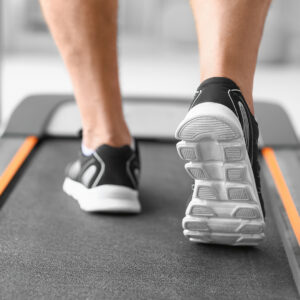Walking Pads 101: Everything You Need to Know

The explosion of walking pads on social media has left many wondering if this increasingly popular home-gym option is right for them.
Orlin & Cohen licensed physical therapist Stephanie Edwards PT, DPT, explains the advantages and disadvantages of walking pads, and how they differ from traditional treadmills, so you can decide if a walking pad is right for you.
Advantages of a walking pad
It’s convenient and easy to use
While it seems as if ordinary treadmills, as well as high-tech stationary bikes and ellipticals have taken over the home-gym world, for many of us the exercise of choice remains a simple walk. A walking pad makes that possible—virtually any time—from the comfort of home.
Essentially a walking machine that’s controlled by your own footsteps, walking pads are an incredible way to get some cardiovascular exercise regardless of the weather or your schedule. In fact, many individuals use a walking pad with a standing desk so they can walk while they work, thus reducing the extra time commitment. Others allow themselves the luxury of catching up on their favorite show while feeling good that they’re still getting some cardio in.
Done walking for the day? Simply fold up (or roll) the walking pad away and store it without using up any precious living space.
It can help you achieve your health goals
We’ve always known how important cardiovascular exercise is—decreasing the likelihood of cardiovascular disease, reducing stress via the release of endorphins, and helping attain other health goals like weight loss.
But it can be difficult to fit a cardio-benefiting walk into your daily life, especially if the weather doesn’t work in your favor. With a walking pad, you can get in your steps every day (or night), rain or shine.
What is the difference between a walking pad and a treadmill?
While both a walking pad and treadmill allow some form of cardiovascular exercise inside the home, there are some important differences. Treadmills are heavy and often immobile, so they take up space in your home. On the other hand, walking pads are smaller, often foldable, and portable so they’re easy to store.
Walking pads are also controlled by sensors under your footsteps, which allow for different speeds, so you can walk faster by walking closer to the front of the pad, and slower by walking towards the back. However, you won’t be able to run on a walking pad (hence the name), as you can on a treadmill, which also may feature an incline option.
Disadvantages of a walking pad
Running isn’t possible
While walking pads are obviously great for walking, many wonder if they’ll be able to run on them. The short answer is no, probably not. Most walking pads will max out at a certain speed (usually between 0.5 to 7.5 miles per hour) making it impossible to run.
Even if the speed seems to be fast enough for running, it’s generally not considered safe to do so, as it can compromise running form and thus cause injury. Again, if running is your main goal, stick with a treadmill.
Slight learning curve
Don’t expect to be walking and working right away. There is a slight learning curve with walking pads so make sure you start slowly and safely, especially if you’re using a walking pad after an injury as part of your rehabilitation process.
Is a walking pad right for me?
In addition to offering a good cardiovascular workout, walking pads can be beneficial during the rehabilitation process for many lower extremity injuries. As with any new form of exercise, however, you should discuss any questions or concerns with your primary physician, orthopedic specialist, or a physical therapist to ensure a walking program using this equipment is right for you.
Have you injured your knee, foot, or ankle—or have unexplained lower extremity pain? We’ve got specialists for that—and same-day appointments. Request yours now.



